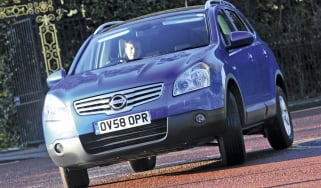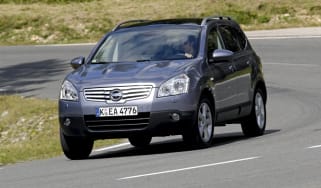Nissan Qashqai+2 (2008-2014) review
With seven seats and rugged off-road looks, the Nissan Qashqai+2 is desirable family choice

When it made its debut, the Nissan Qashqai single-handedly invented the compact crossover sector. Since then, the British-built machine has gone from strength to strength, and spawned a whole host of rivals, including the Skoda Yeti and Mazda CX-5. However, unlike many of its competitors, the Nissan is available as a practical seven-seater. Revealed in 2008 and facelifted in 2010, the Qashqai+2 is slightly longer than the standard car, but shares its decent driving dynamics and low family car running costs.
Engines, performance and drive
Despite its high-riding stance, the Qashqai+2 feels most at home on tarmac. Accurate steering, strong body control, decent grip and a comfortable ride mean the Nissan is remarkably car-like on the move. Yet it combines this agility with a high-set SUV driving position that gives a commanding view of the road. What’s more, there’s the option of a four-wheel drive version for owners that do want to head off-road. The 1.6-litre and 2.0-lite petrol engines are thirsty, so for most owners the smooth and frugal 1.5-litre, 1.6-litre and 2.0-litre dCi diesels will be the best bet. A slick five or six-speed manual gearbox is standard on most models, while the four-wheel drive versions are only available with an automatic transmission (a CVT on the 2.0-litre petrol and a traditional auto on the 2.0-litre diesel).
MPG, CO2 and Running Costs
Buyers wanting to keep their motoring bills to a minimum should steer clear of the four-wheel drive 2.0-litre petrol, as it emits a hefty 194g/km of CO2 and will struggle to return 35mpg. The cleanest and most economical powerplant in the line-up is the new 128bhp 1.6-litre dCi diesel, which delivers claimed fuel returns of 60.1mpg and CO2 emissions of only 123g/km. Currently, only the 1.6-litre diesel and petrol models get fuel-saving stop/start technology. Servicing costs should be similar to mainstream hatchback rivals such as the VW Golf, while all Qashqai+2 variants hold onto around 40 per cent of their value after three years motoring.
Interior, design and technology
At a glance, the Nissan Qashqai+2 is almost identical to the five-seat version, which means you get the same chunky SUV inspired styling cues and raised ride height. However, take a closer a look and you’ll spot the seven-seater’s extended wheelbase and longer rear overhang. All versions get alloy wheels, while range-topping n-tec+ and Tekna models benefit from rear privacy glass and silver roof rails. Inside, the Nissan’s dashboard looks a little dated, plus it can’t match the Skoda Yeti for upmarket appeal. Yet while some of the materials feel a little low rent, the cabin is robustly constructed and well-equipped, with air-conditioning and Bluetooth featuring across the range.
Practicality, comfort and boot space
With its seven-seat layout, the Qashqai+2 is a more versatile choice than compact crossover rivals such as the Peugeot 3008. Yet it’s worth bearing in mind that the seats in the third row are cramped, and when they’re in place there’s virtually no space for luggage. However, in five-seat form the Qashqai+2 boasts a generous 450-litre load bay, while a sliding second row bench allows you to increase either legroom or boot space. What’s more, the rest of the cabin is crammed with useful storage, including a 14-litre glovebox, deep door bins and a lidded cubby in the centre console.
Reliability and Safety
The five-seat Nissan Qashqai scored a five-star EuroNCAP rating, so there’s every reason to expect the Qashqai+2 to be equally strong in a crash. All versions benefit from six airbags, ESP and active head restraints, while LED daytime running lights are an extra cost option. Nissan has a well-earned reputation for reliability, and the Qashqai is one of its most dependable models, even once securing an impressive top five finish in our Driver Power satisfaction survey.






